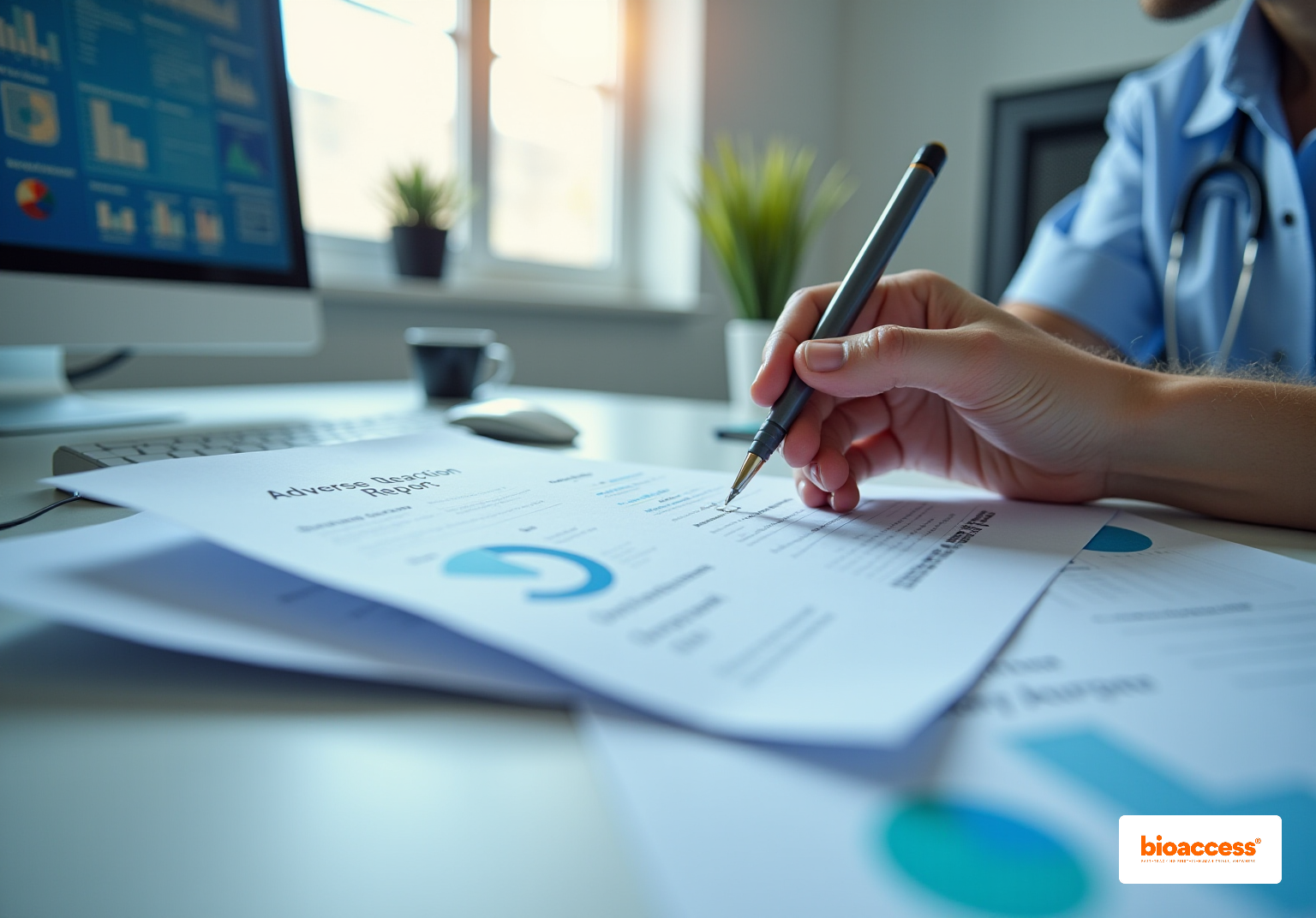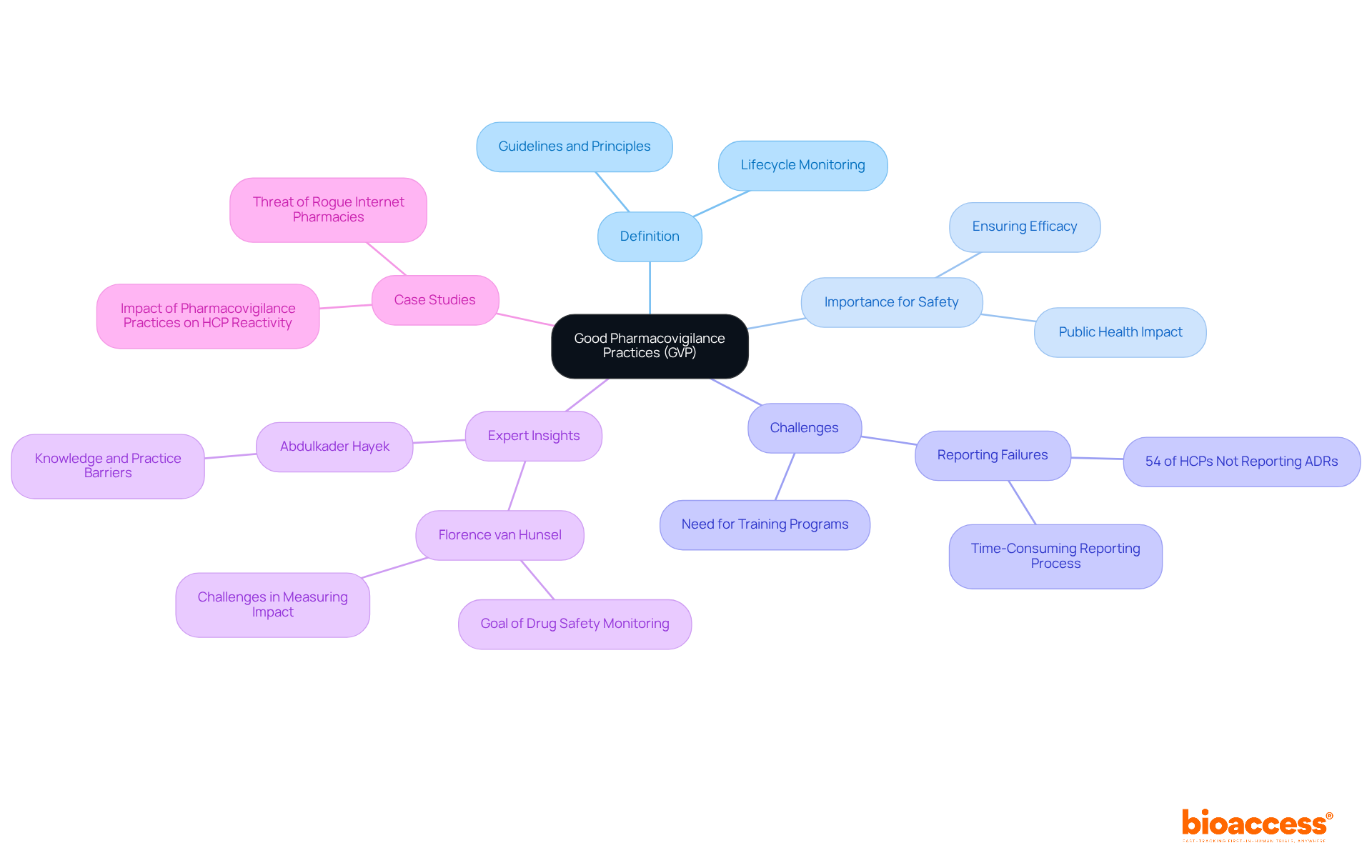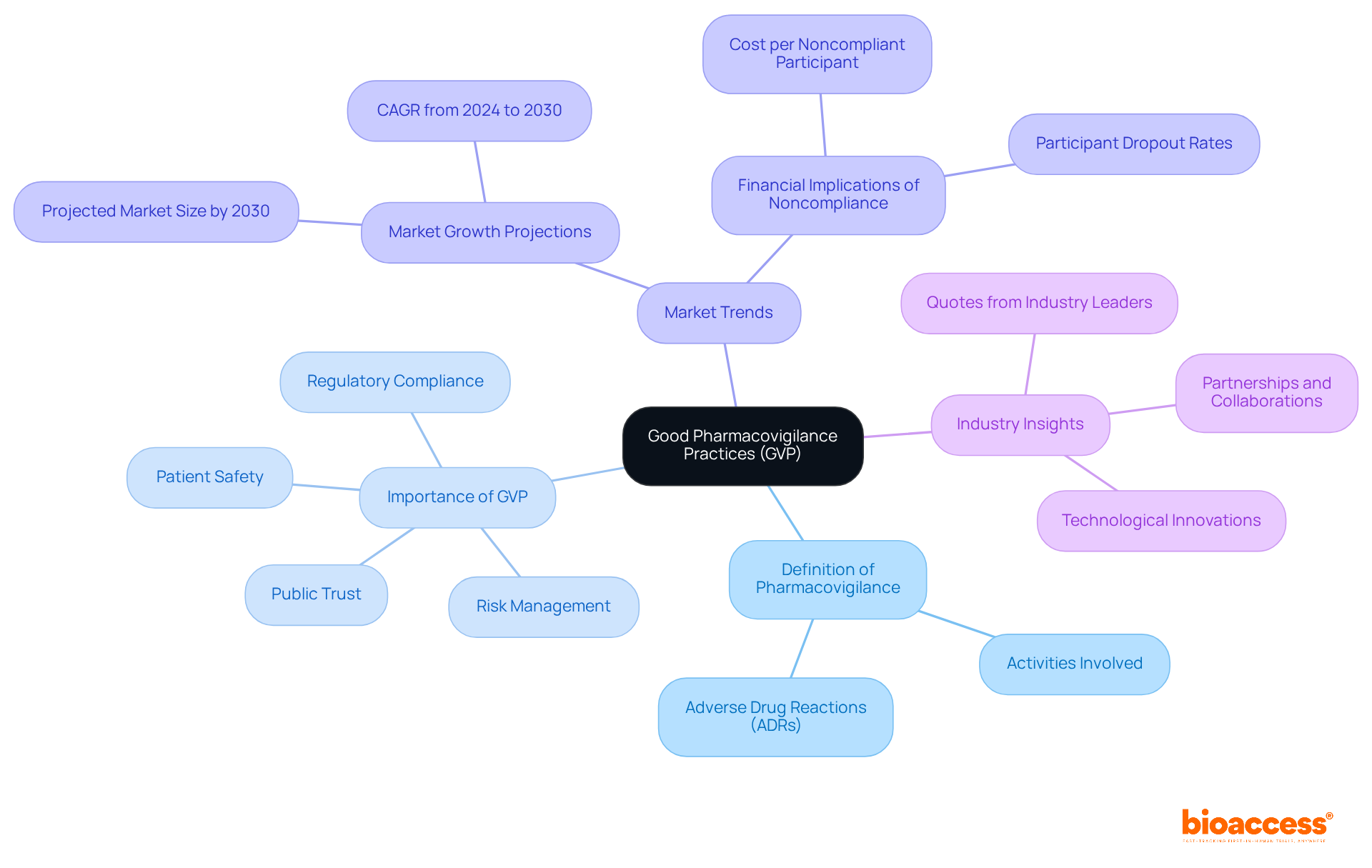


Good Pharmacovigilance Practices (GVP) serve as essential guidelines and principles, designed to ensure the safety and efficacy of pharmaceutical products. By systematically monitoring and managing adverse drug reactions throughout their lifecycle, GVP not only aids in regulatory compliance but also significantly enhances patient safety.
Furthermore, it underscores the critical need for improved reporting and training among healthcare professionals. This proactive approach is vital for effectively mitigating the risks associated with medications, ensuring that patient welfare remains at the forefront of pharmaceutical care.
Understanding Good Pharmacovigilance Practices (GVP) is essential in a world where the safety of pharmaceutical products is paramount. These guidelines not only ensure the efficacy of medications but also play a critical role in safeguarding public health by systematically monitoring and addressing adverse reactions.
Despite their importance, however, a significant gap in the reporting of adverse effects persists among healthcare professionals. This raises critical questions about the effectiveness of current practices.
How can the pharmaceutical industry enhance adherence to GVP and ultimately improve patient outcomes?
Good Pharmacovigilance Practices (GVP) refer to what is GVP, encompassing a set of guidelines and principles aimed at ensuring the safety and efficacy of pharmaceutical products throughout their lifecycle. These practices involve systematic processes for monitoring, assessing, and preventing adverse reactions and related issues. Crucially, understanding what is GVP plays a vital role in maintaining public health by ensuring that the benefits of medications outweigh their risks. Interestingly, a study revealed that 54% of healthcare professionals failed to report adverse effects, highlighting significant challenges in GVP adherence.
Furthermore, understanding what is GVP is paramount for regulatory compliance, providing a framework for pharmaceutical firms to protect patient safety and enhance medication safety oversight. Expert Florence van Hunsel emphasizes that 'the goal of drug safety monitoring is to reduce harm by more appropriate use of medicines,' which underscores what is GVP and its critical role in safeguarding public health. Successful drug safety monitoring systems established by leading pharmaceutical firms illustrate the effectiveness of these practices in identifying and mitigating risks associated with medication therapies.
For instance, a recent study assessed how enhanced pharmacovigilance practices during the COVID-19 period positively influenced healthcare professionals' responsiveness in reporting adverse drug reactions (ADRs). This validates the necessity for training programs aimed at fostering a robust ADR reporting culture. Ultimately, this comprehensive approach significantly contributes to improved patient outcomes.

Pharmacovigilance encompasses the science and activities aimed at detecting, assessing, understanding, and preventing adverse effects or any drug-related issues. Understanding what is GVP is essential, as Good Pharmacovigilance Practices establish the foundation of this field and provide crucial guidelines for the systematic collection and analysis of risk data. By understanding what is GVP, pharmaceutical companies not only adhere to regulatory requirements but also maintain rigorous monitoring standards. This structured approach enables organizations to effectively manage risks associated with their products, significantly enhancing patient safety and fostering public trust in the healthcare system.
Recent trends indicate a growing emphasis on what is GVP, as the global pharmacovigilance market is projected to reach USD 11.78 billion by 2030, reflecting a compound annual growth rate (CAGR) of 6.5% from 2024 to 2030. The market size was estimated at USD 7.95 billion in 2024 and is expected to reach USD 8.58 billion in 2025. Organizations are progressively acknowledging what is GVP, recognizing its significance in reducing negative medication reactions (ADRs), which can lead to considerable financial setbacks—estimated at USD 19,500 per noncompliant participant in clinical trials.
Industry leaders emphasize what is GVP as crucial for drug security. For instance, Jonathan Shough, Chief Information Officer for Parexel, stated, "We're thrilled to expand our collaboration with Palantir - a leader in artificial intelligence technology - as we build on our application of AI to further improve clinical trial execution and advance our offerings in Real World Evidence, advanced analytics and Health Outcomes." This partnership seeks to enhance clinical trial execution by improving data clarity and efficiency, showcasing what is GVP and how it can foster innovation in practice. As the monitoring framework evolves, it is crucial to understand what is GVP to ensure that patient well-being is prioritized, ultimately resulting in improved health outcomes and heightened trust in pharmaceutical products.

The evolution of medication monitoring has been profoundly shaped by significant health crises, notably the thalidomide disaster of the 1960s, which led to thousands of serious birth defects. This catastrophic event highlighted the urgent need for comprehensive medication oversight and prompted regulatory agencies to establish rigorous protocols for monitoring medicinal products.
In this context, the European Medicines Agency (EMA) and the World Health Organization (WHO) have played pivotal roles in formulating Good Pharmacovigilance Practices (GVP), which help clarify what is GVP by providing detailed frameworks addressing the complex nature of drug safety monitoring. Over the years, the concept of what is GVP has expanded to encompass various modules, each focusing on distinct aspects of drug safety monitoring, thereby ensuring a thorough and systematic approach to protecting public health.
The lessons learned from past crises continue to inform current practices, reinforcing the significance of proactive monitoring and regulatory compliance within the pharmaceutical industry. Notably, the EMA reported a nearly 29% increase in inspections, underscoring the growing regulatory oversight in drug safety. The WHO characterizes drug monitoring as a system for supervising the security of pharmacotherapies, emphasizing its critical role in public health.
Furthermore, historical incidents such as the Sulfanilamide tragedy in 1937, which resulted in the poisoning of over 100 individuals, further illustrate the necessity for stringent safety protocols in pharmaceuticals. The establishment of the International Conference on Harmonisation in the 1990s also significantly contributed to aligning approval criteria across nations, enhancing the development of pharmacovigilance practices.

Key components of Good Pharmacovigilance Practices (GVP) include:
Adverse Medication Reaction Reporting: Establishing efficient systems for the timely reporting of adverse medication reactions (ADRs) is crucial. This ensures that safety signals are identified and addressed promptly, thereby enhancing patient safety. Recent studies indicate that educational interventions can significantly improve awareness and knowledge of reporting systems among healthcare professionals, which is vital for effective ADR reporting. Notably, a survey revealed that only 18.4% of respondents in Wales knew how to report a side effect to the UK Yellow Card scheme, highlighting a significant knowledge gap.
Risk Management: Developing comprehensive risk management plans (RMPs) is essential for outlining strategies to minimize risks associated with drug use. The European Medicines Agency (EMA) requires RMPs for all newly authorized products, underscoring the significance of proactive risk assessment in drug safety monitoring.
Signal Detection: Implementing robust processes for the identification and evaluation of safety signals is necessary to detect potential safety concerns early. Statistical methods, including disproportionality analysis, have traditionally dominated ADR signal detection studies. However, recent advancements in machine learning are gaining traction, with 38.1% of studies in 2018 utilizing these methods, thereby offering new avenues for signal detection.
Documentation and Record Keeping: Maintaining comprehensive records of all drug safety activities is vital for ensuring compliance with regulatory requirements. This documentation promotes transparency and accountability in drug safety practices, which is essential for regulatory inspections and audits.
Training and Education: Providing ongoing training for staff engaged in drug safety monitoring is critical to ensure they remain knowledgeable about current practices and regulations. Ongoing educational programs have demonstrated the ability to improve the efficiency of ADR reporting and management, promoting a culture of security within healthcare environments. Furthermore, there is a recognized need for enhanced medication safety education for undergraduate healthcare students, underscoring the broader implications of training initiatives.
These components work synergistically to create a robust pharmacovigilance system, highlighting what is GVP in enhancing drug safety and protecting patient health.

Good Pharmacovigilance Practices (GVP) constitute a vital framework for ensuring the safety and efficacy of pharmaceutical products throughout their lifecycle. By establishing systematic processes for monitoring and assessing adverse reactions, GVP plays a pivotal role in safeguarding public health. Adhering to these practices not only enhances regulatory compliance but also fosters a culture of safety in medication use, ultimately ensuring that the benefits of treatments outweigh their risks.
Key insights from the article underscore the essential components of GVP, including:
The evolution of pharmacovigilance, shaped by historical health crises, highlights the necessity for robust monitoring systems that adapt to emerging challenges. As the global pharmacovigilance market continues to expand, the significance of GVP in mitigating risks and improving patient outcomes becomes increasingly apparent.
Recognizing the importance of GVP, it is evident that a commitment to these practices is vital for the advancement of drug safety. Stakeholders in the pharmaceutical industry must prioritize training, awareness, and compliance to cultivate a proactive approach to pharmacovigilance. By doing so, they not only enhance patient safety but also restore public trust in the healthcare system, ensuring that medications can be utilized safely and effectively in the years to come.
What are Good Pharmacovigilance Practices (GVP)?
Good Pharmacovigilance Practices (GVP) are guidelines and principles designed to ensure the safety and efficacy of pharmaceutical products throughout their lifecycle. They involve systematic processes for monitoring, assessing, and preventing adverse reactions and related issues.
Why is understanding GVP important?
Understanding GVP is crucial for maintaining public health by ensuring that the benefits of medications outweigh their risks. It also plays a key role in regulatory compliance, helping pharmaceutical firms to protect patient safety and enhance medication safety oversight.
What challenges exist in GVP adherence?
A study revealed that 54% of healthcare professionals failed to report adverse effects, indicating significant challenges in adhering to GVP.
What is the goal of drug safety monitoring according to experts?
The goal of drug safety monitoring is to reduce harm through more appropriate use of medicines, as emphasized by expert Florence van Hunsel.
How have successful drug safety monitoring systems impacted GVP?
Successful drug safety monitoring systems established by leading pharmaceutical firms have demonstrated effectiveness in identifying and mitigating risks associated with medication therapies.
How did enhanced pharmacovigilance practices during COVID-19 affect reporting of adverse drug reactions (ADRs)?
Enhanced pharmacovigilance practices during the COVID-19 period positively influenced healthcare professionals' responsiveness in reporting ADRs, highlighting the importance of training programs to foster a robust ADR reporting culture.
What is the overall impact of GVP on patient outcomes?
A comprehensive approach to GVP significantly contributes to improved patient outcomes by ensuring better monitoring and reporting of adverse drug reactions.